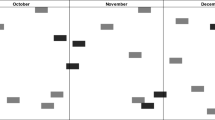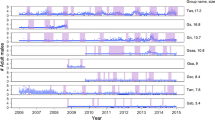Abstract
As applied to polygynous mammals, the socioecological model assumes that environmental risks and resources determine the spatial and temporal distribution of females, which then sets male strategies for monopolizing fertile matings. The effects of female spatial distribution (i.e., female number) and temporal overlap (female mating synchrony) have been examined in comparative studies of primates, but the relative influence of these two factors on male monopolization potential (the number of males) remains unclear. One particular problem is that female synchrony is more difficult to estimate than female number. This paper uses multivariate statistical methods and three independent estimates of female synchrony to assess the roles of spatial and temporal effects in the context of a phylogenetically corrected dataset. These analyses are based on sensitivity analyses involving a total of four phylogenies, with two sets of branch length estimates for each tree, and one nonphylogenetic analysis in which species values are used (because male behavior may represent a facultative response to the distribution of females). The results show: (1) that breeding seasonality predicts male number (statistically significant in six out of nine sensitivity tests); (2) that expected female overlap, after controlling for female group size using residuals, also accounts for the number of males in primate groups (significant in eight out of nine tests), and (3) that actual estimates of female mating synchrony predict male number, again after correcting for female group size (significant in five out of nine tests). Nonsignificant results are in the predicted direction, and female group size is significant in all statistical tests. These analyses therefore demonstrate an independent influence of female temporal overlap on male monopolization strategies in mammalian social systems.
Similar content being viewed by others
Author information
Authors and Affiliations
Additional information
Received: 24 July 1998 / Received in revised form: 5 February 1999 / Accepted: 7 February 1999
Rights and permissions
About this article
Cite this article
Nunn, C. The number of males in primate social groups: a comparative test of the socioecological model. Behav Ecol Sociobiol 46, 1–13 (1999). https://doi.org/10.1007/s002650050586
Issue Date:
DOI: https://doi.org/10.1007/s002650050586




